New & Improved Portable, Paperless, Digital Copy Machine
by DHagen in Craft > Photography
139322 Views, 364 Favorites, 0 Comments
New & Improved Portable, Paperless, Digital Copy Machine
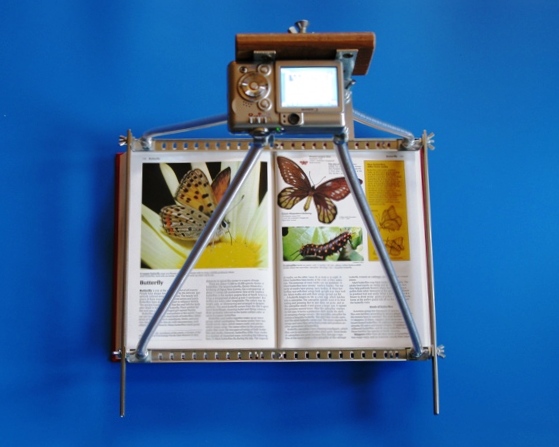
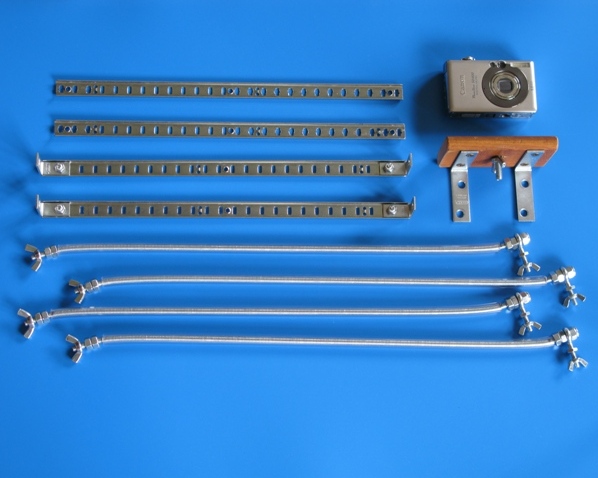
Don’t wait in line to feed coins into the library’s photocopier!
Here are instructions for making a portable, paperless, digital copy machine.
[Earlier I published a version of this that had a clear-plastic “page press”. In some cases, there was too much reflection off of the plastic, and I couldn’t get good copies. This new version has an adjustable, windowless frame for pressing the pages flat. This version is cheaper to make and packs up smaller than before.]
Your materials should cost less than $20, maybe less than $10, and the labor time should be only a few hours. I am assuming that you already have a digital camera and a computer for downloading pictures. Of course, your camera will do most of the work here, but you will provide it with a steady stand that has a press for getting those book pages flat.
The pictures show what the final device looks like, fully assembled …
and broken down for transport.
I suggest several, options for improving your copies – in some cases, low-cost software is involved. If you follow all of the options, you can convert your images into word-searchable documents. You can’t search for keywords in the pages you get off of a copy machine! And think of the trees you will save by going paperless!
(The book example is World Book Encyclopedia, 1989.)
Parts Needed
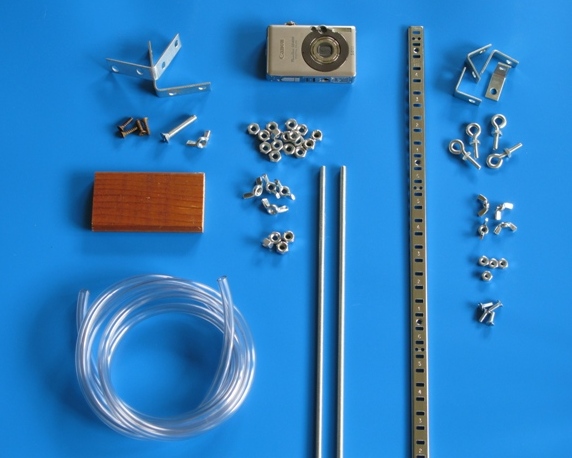
2x threaded rods, 36” x 1/4”
1x Tygon tubing, 6’ x 1/4” inside diameter
16x 1/4” nuts
5x 1/4” wing nuts
4x 1/4” stop nuts or acorn nuts
1x 1 1/2” x 1/4” bolt
1x wood scrap, about 4” x 2” x 1/2” (size depends on your camera)
2x 2” angle brackets (with 1/4” holes)
4x wood screws, 1/2”
1x shelf track (the kind for adjustable shelving), 6’
4x 1” angle brackets
4x 3/16” threaded “eyes” (they come with nuts)
4x 3/16” wing nuts
4x 1/2” x 1/8” bolts
4x 1/8” nuts
Tools Needed
electric drill and bits
hacksaw (for cutting the threaded rods)
electric drill and bits
hacksaw (for cutting the threaded rods)
vise (for bending the rods & holding the track for drilling)
two wrenches (adjustable or fixed-gap wrenches of 7/16” or 11 mm, or pliers)
Assemble the Camera Mount
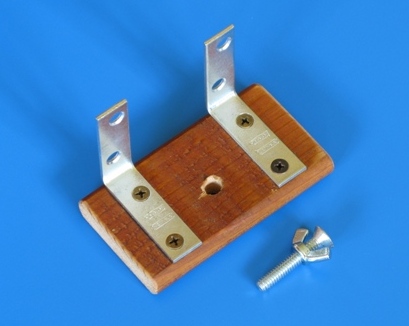
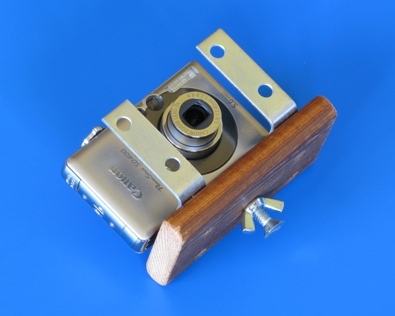
Position the angle brackets onto the wood scrap.
(Mine are 3” apart.)
Mark the holes.
Drill pilot holes for the wood screws.
Screw the angle brackets in place.
Position the camera, with its lens centered between the brackets.
(Leave clearance for the wingnuts – read ahead.)
Mark the position of the camera’s threaded, tripod hole.
Drill a 5/16” hole for the 1 ½” x ¼” bolt.
Prepare the Page-press
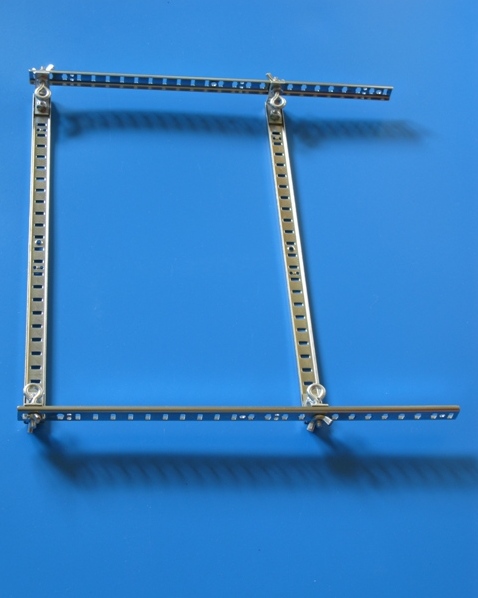
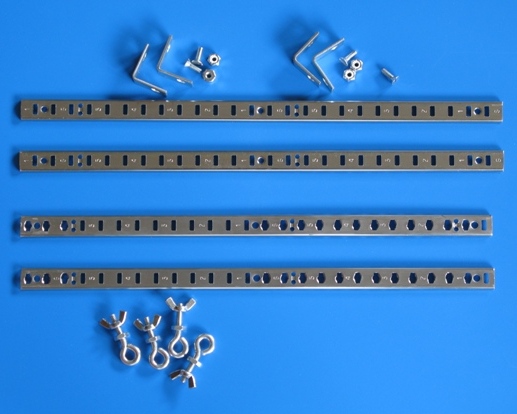
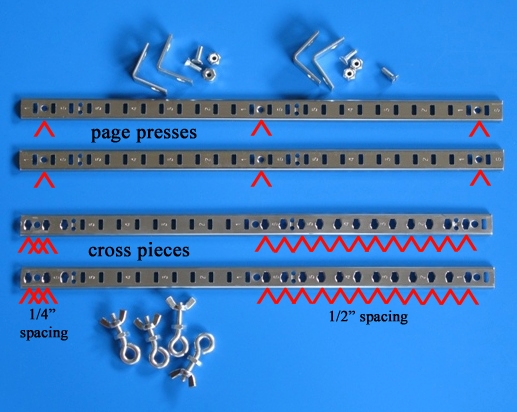
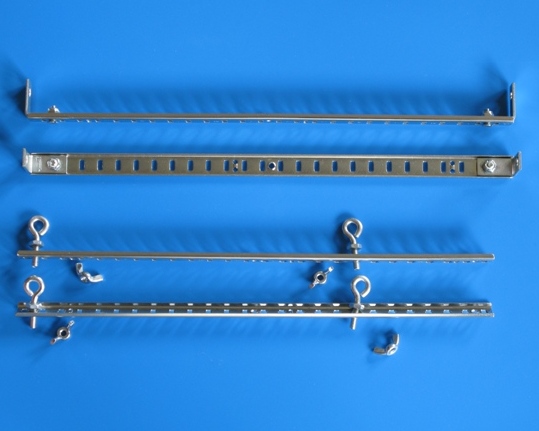
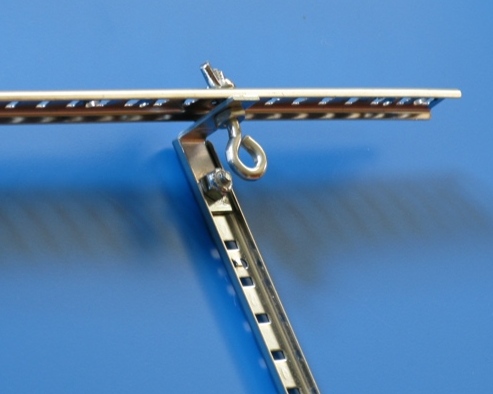
Cut the track material into suitable lengths
(My pressing pieces are 13 1/4” and my cross pieces are 13”, all cut as indicated relative to the adjustment marks on the tracks – see the second photo)
Use a file to smooth off the corners and edges.
(My pressing pieces are 13 1/4” and my cross pieces are 13”, all cut as indicated relative to the adjustment marks on the tracks – see the second photo)
Use a file to smooth off the corners and edges.
Drill 3/16” holes at the positions indicated; refer to the third photo.
(WARNING: Drilling round holes into the rectangular slots is not trivial and can be dangerous. Wear eye protection, hold the pieces in a vise, etc., etc. I found it easiest to first enlarge the slots by hammering in a tapered tool (a nail set), then drilling the holes.)
(WARNING: Drilling round holes into the rectangular slots is not trivial and can be dangerous. Wear eye protection, hold the pieces in a vise, etc., etc. I found it easiest to first enlarge the slots by hammering in a tapered tool (a nail set), then drilling the holes.)
Prepare the Rods
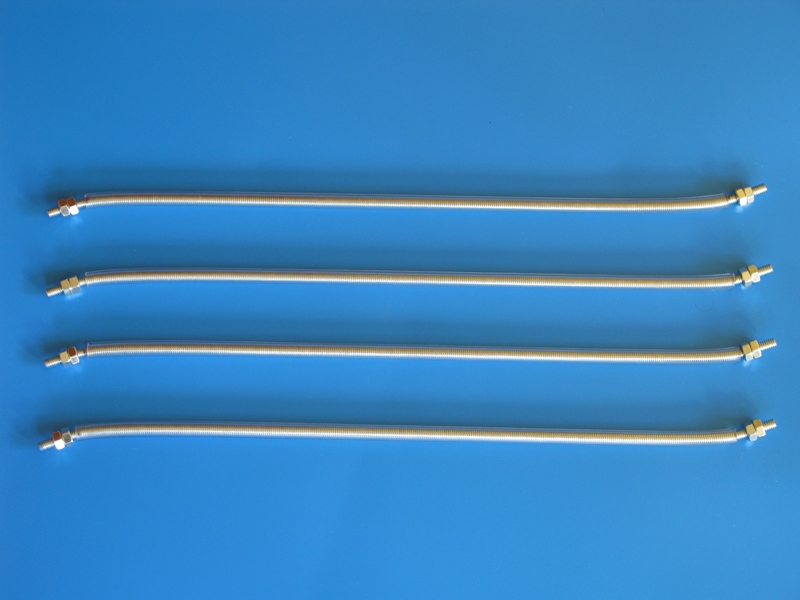
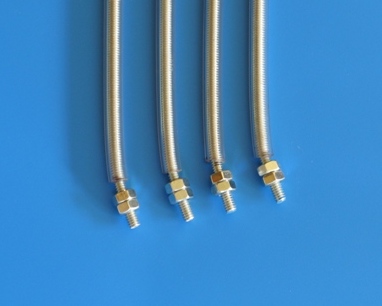
Cut each 36” threaded rod in two; now you have four 18” rods.
Round off the cut ends with a file.
Check the threads of the cut ends with a nut.
(You may have to apply the nut onto the opposite end, then run it all the way up and off of the newly cut end.)
Mark each rod at 1” from each end.
Cut four 16” lengths of the Tygon tubing.
Slip the tubing over each rod.
Use a 1” scrap of tubing to protect the exposed threads in the bending process.
Bend one end of each rod at the mark to about 20° UP from straight.
(Slip the short tubing piece over the end before clamping it in the vise or pliers. Keep the outer ¾” of the rod as straight as possible.)
Bend the unbent end of each rod, at the mark, to about 20° DOWN from straight.
(Bend it in the opposite direction from the first bend! Keep the outer ¾” of the rod as straight as possible.)
Thread two bolts onto each end of the rods.
Cut each 36” threaded rod in two; now you have four 18” rods.
Round off the cut ends with a file.
Check the threads of the cut ends with a nut.
(You may have to apply the nut onto the opposite end, then run it all the way up and off of the newly cut end.)
Mark each rod at 1” from each end.
Cut four 16” lengths of the Tygon tubing.
Slip the tubing over each rod.
Use a 1” scrap of tubing to protect the exposed threads in the bending process.
Bend one end of each rod at the mark to about 20° UP from straight.
(Slip the short tubing piece over the end before clamping it in the vise or pliers. Keep the outer ¾” of the rod as straight as possible.)
Bend the unbent end of each rod, at the mark, to about 20° DOWN from straight.
(Bend it in the opposite direction from the first bend! Keep the outer ¾” of the rod as straight as possible.)
Thread two bolts onto each end of the rods.
(Each pair of bolts will be locked into position; the exact positions will be determined later.)
Final Assembly
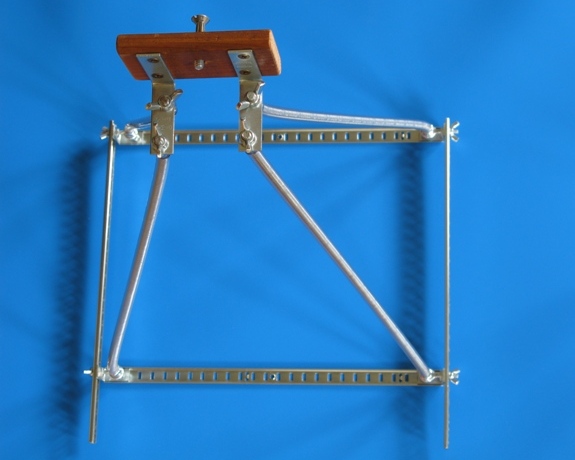
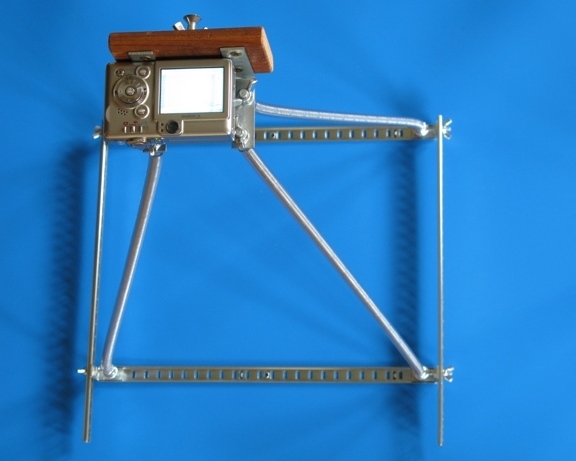
Assemble the frame to an appropriate size depending on the book or magazine you want to copy. It’s easiest to make the frame with the rod-bottoms already mounted in the threaded “eyes”.
(You can copy large books or small, vertically or horizontally, sometimes two pages at a time – see various examples in the Step 6 photos.)
Remove the camera from the camera mount, if it's still mounted.
Insert the tops of the four rods into the bracket holes of the camera mount. Secure the tops with the wing nuts.
(The camera mount can go either vertically or horizontally.)
Mount the camera and check the alignment.
(Adjust the top, locked nuts as needed. Determine the best position for the nuts below the wingnuts, and lock them together.)
(The camera mount can go either vertically or horizontally.)
Mount the camera and check the alignment.
(Adjust the top, locked nuts as needed. Determine the best position for the nuts below the wingnuts, and lock them together.)
Copy Some Documents
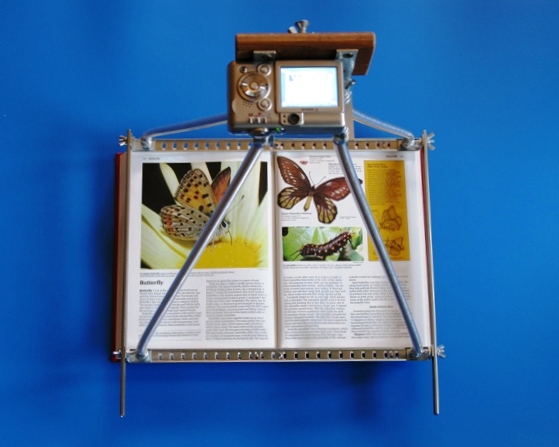
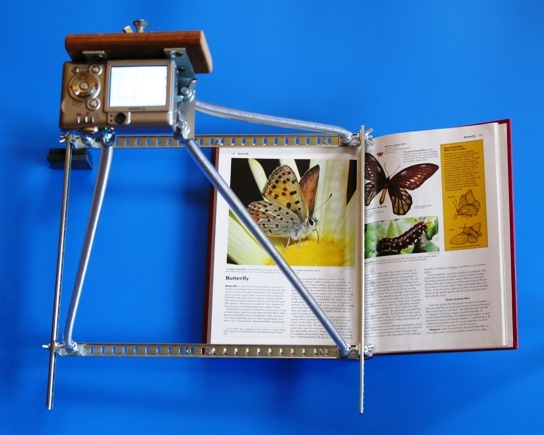

Turn off the flash.
(It’s not needed; it reflects off of the page; and it’s annoying in the library! Shift things around to avoid reflections and shadows. Long exposures are OK because everything is steady.)
Press the frame tightly onto the book so you can see all of the text.
Zoom in, as appropriate.
Snap a picture.
Turn the page
Repeat as needed.
(The book examples are: World Book Encyclopedia, 1989, and The Butterflies of Cascadia, Robert Pyle, 2002.)
(The book examples are: World Book Encyclopedia, 1989, and The Butterflies of Cascadia, Robert Pyle, 2002.)
Clean Up the Images (Optional)
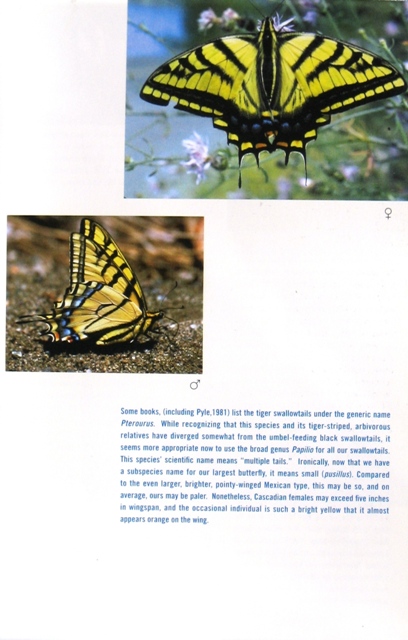
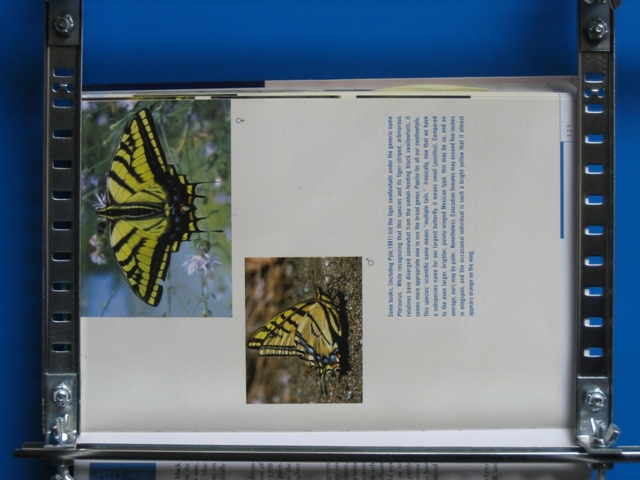
Use some simple photo-editing software to …
- Rotate the image, if it is out of alignment.
- Crop the image.
- Adjust the brightness and contrast.
- Fix photo aberrations (e.g. pincushioning).
Paste the Images Into One Document (Optional)
Prepare a dummy document using MS Word (or another word processing program).
Make a blank page for each image.
Give each blank page has a few Returns then a Page Break.
Cut one image at a time and Paste it into the dummy document.
Save the document.
Convert the Word Document Into a Pdf File (Optional)
Why? See Option 10, below. Several programs (e.g. Abbyy Transformer or Cute PDF Writer) convert Word files to Pdfs.
(Some conversion programs are freeware.)
Convert Your Pdf Files Into Word-searchable Pdf Files
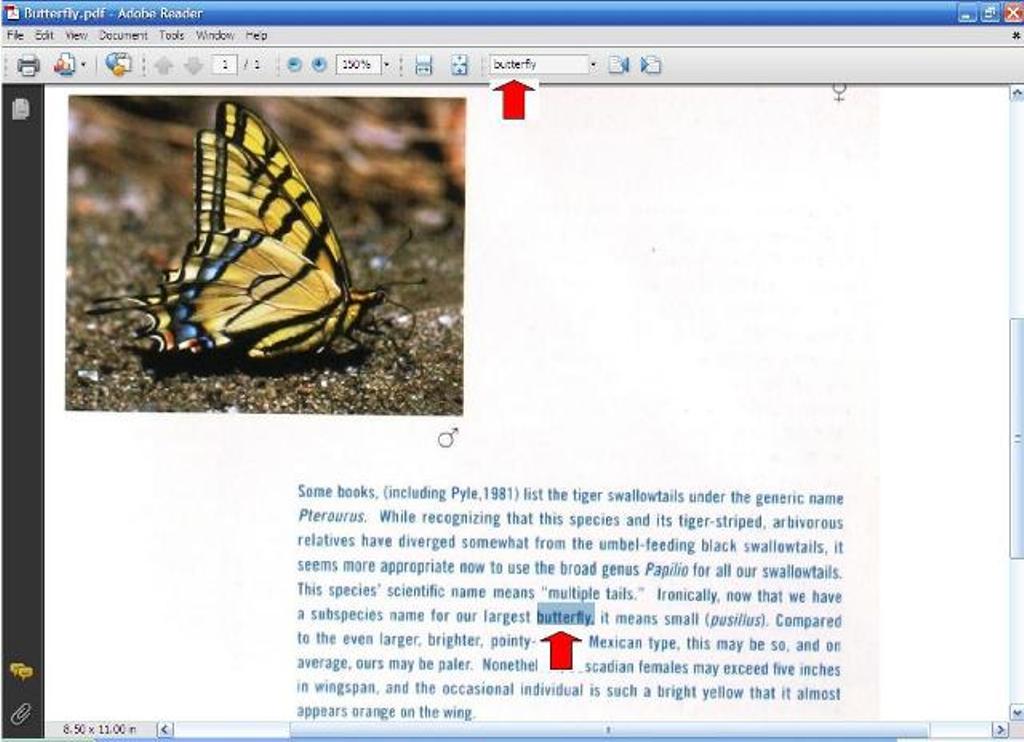
Several programs, e.g. Abbyy Transformer (~$49), do a good job with optical character recognition (OCR) converting Pdfs into searchable Pdfs. You can now search for keywords in your copied document! You can’t do this with the pages you get off of a Xerox copier.
AND … You saved a few trees by going paperless! Thank you.